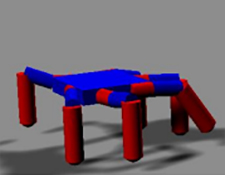Consider a terrestrial robot navigating in an obstacle-filled environment. Or an uncrewed vehicle landing for the first time in a new world. How about designing a new, autonomous marine system propelled by waves? Finding solutions to these problems is inherently difficult and time-consuming. There’s a very large number of parameters and configuration settings that determine the design and control of complex cyber physical systems (CPS), such as robots, uncrewed vehicles, and other autonomous platforms. Along with this huge solution space, there are many operational requirements that must be enforced to ensure that the system operates correctly, efficiently, safely, and securely. These operational requirements create an enormous set of interdependent constraints on the solution space, each of which must be satisfied for a valid solution.
Peraton Labs has been at the forefront of research to develop new techniques, useful toolkits, and automated, intelligent methods for efficient, accurate, and secure design and control of CPS and autonomous systems. Our novel, AI-driven approach significantly shortens the solution cycle, greatly reduces effort and cost, guarantees operational accuracy and safety, and enhances solution innovation. Our approach is extremely efficient at learning the promising areas of the solution space and rapidly identifying candidate solutions, providing critical advantages over current alternatives. We ensure that operational environment and mission requirements are met so that system designs and controls are correct and secure by design. We can also quickly find solutions that provide design robustness to changes in the requirements as well as solutions for redesign and repair to accommodate degradations in the system or alterations in the requirements. We’ve published some exciting results collaborating with partners to apply our approach to problems in CPS design and control.
Wave glider design
This challenge is to design an autonomous marine vehicle that propels itself with wave energy and can sail at a given steady-state velocity for a given wave condition. Working with an academic partner, we produced a verifiably correct design within 5 minutes when alternate methods failed to find any design that met the operational constraints.
Safe robot path finding
Given a robot, its initial position, a set of obstacles, and a desired final position, this challenge is to find a least-cost path for the robot to maneuver from the initial position to the final position. Despite the very large number of possible paths, we were able to find a solution whose cost was 67% lower than that from one of the best optimization tools, without any increase in the time required to determine our solution.
Hexapod robot repair

This challenge involves a damaged hexapod robot, for which new controls are needed to allow the robot to walk again, at the highest possible speed and without falling. Using our approach in collaboration with an academic partner, we identified a solution whose speed was 30% higher than that produced by competing methods, and we did so in the same amount of time.
The core of our approach is a novel, patent-pending technique called Constrained Optimization with Neural Networks, Mixed Integer Linear Programming, and Active Learning (CNMA). Leveraging a unique combination of machine learning, neural network models, and efficient and parallelized algorithms, CNMA is a new, sample-efficient method that produces fully compliant solutions substantially faster than competing approaches and finds solutions when other approaches fail.
CNMA models the challenge as a constrained optimization problem in which the objective is to develop an optimum design – with respect to performance attributes such as speed, cost, or efficiency — which meets a large, complex set of requirements and constraints. CNMA harnesses the ability of neural networks (NNs) to approximate any continuous function, transforms the NNs into equivalent mixed integer linear programs (MILPs), and applies industrial strength MILP solvers to generate fast solutions. Importantly, our innovative use of active machine learning means that CNMA quickly zeros in on promising regions of the solution space, reducing the number of time-consuming evaluations of candidate solutions by orders of magnitude compared to alternate approaches.
We are continuing to advance our CNMA-based solution and look forward to leveraging its substantial advantages in speed, efficiency, accuracy, and safety to address important problems in the design, control, and repair of autonomous systems capable of increasingly complex maneuvers and behavior.




